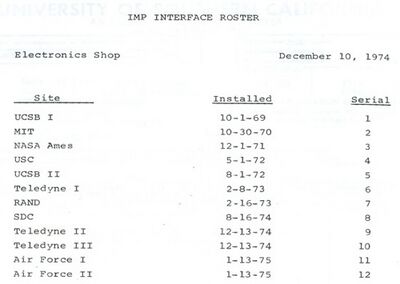Difference between revisions of "IMP interface"
From Computer History Wiki
(link 1822) |
m (Link System/360) |
||
| (14 intermediate revisions by 2 users not shown) | |||
| Line 1: | Line 1: | ||
| − | + | [[Image:IMP-interface-roster.jpg|thumb|right|400px|IMP interfaces for IBM S/360]] | |
| − | + | An '''IMP interface''' is a [[device controller]] used on a [[host]] (i.e. on its [[bus]]) to attach them to systems which used the special [[1822 interface|1822 communication interface]] (defined in [[Bolt, Beranek, and Newman|BBN]] Report No. 1822); these included initially the [[Interface Message Processor|IMPs]] of the [[ARPANET]] (hence the name), and later the PRUs of the [[Packet Radio Network]]. | |
| + | |||
| + | Some of the most popular IMP interfaces were: | ||
* BBN IMP-10, used by [[TENEX]] | * BBN IMP-10, used by [[TENEX]] | ||
* MIT DM IMP, used by [[Incompatible Timesharing System|MIT-DM]]. Made by Bob Metcalfe | * MIT DM IMP, used by [[Incompatible Timesharing System|MIT-DM]]. Made by Bob Metcalfe | ||
* MIT KA IMP, used by [[Incompatible Timesharing System|MIT-AI, -ML, and -MC]] | * MIT KA IMP, used by [[Incompatible Timesharing System|MIT-AI, -ML, and -MC]] | ||
| − | * [[Digital Equipment Corporation|DEC]] AN-10 | + | * [[Digital Equipment Corporation|DEC]] AN-10, for the [[PDP-10 I/O Bus]] |
* DEC CSS [[IMP11-A ARPANET interface|IMP11-A]], [[UNIBUS]] | * DEC CSS [[IMP11-A ARPANET interface|IMP11-A]], [[UNIBUS]] | ||
| + | * DEC CSS [[IMP11-B ARPANET Interface|IMP11-B]], UNIBUS | ||
| + | * [[ANTS/ISI IMP Interface]], UNIBUS | ||
* [[Stanford 1822 Interface]], UNIBUS (via a [[DR11-C parallel interface|DR11-C]]) and [[QBUS]] (via a [[DRV11 Parallel Line Unit|DRV11]]) | * [[Stanford 1822 Interface]], UNIBUS (via a [[DR11-C parallel interface|DR11-C]]) and [[QBUS]] (via a [[DRV11 Parallel Line Unit|DRV11]]) | ||
* [[Advanced Computer Communications|ACC]] [[LH-DH/11 Local/Distant Host Controller|LH-DH/11]], UNIBUS | * [[Advanced Computer Communications|ACC]] [[LH-DH/11 Local/Distant Host Controller|LH-DH/11]], UNIBUS | ||
* ACC [[MLH-DH/LSI11 Multiple Channel Controller|MLH-DH/LSI11]], QBUS | * ACC [[MLH-DH/LSI11 Multiple Channel Controller|MLH-DH/LSI11]], QBUS | ||
* GIMPSPIF, used by 645 [[Multics]] | * GIMPSPIF, used by 645 [[Multics]] | ||
| − | * ABSI, used by [[Honeywell 6000 series|6180]] Multics | + | * ABSI, used by [[Honeywell 6000 series|6180]] Multics, for NCP and [[Internet Protocol|IP]] |
| + | * [[Alto-1822 Interface]] for the [[Xerox Alto|Alto]], used in a variety of ways | ||
| + | * [[Data General Nova]] interface: done at [[Xerox PARC]], apparently at least two, almost certainly two: one for [[Maxc]]1's [[front end]] and another for the Portola PUP gateway | ||
| + | * The USCB IMP interface, first for their [[IBM System/360|360/75]], later sold to other institutions. | ||
but there were many others (many being 'one-off' local creations). | but there were many others (many being 'one-off' local creations). | ||
| Line 21: | Line 28: | ||
* [http://www.bitsavers.org/pdf/bbn/imp/BBN1822_Jan1976.pdf Specification for the Interconnection of a Host and an IMP] - BBN Report #1822 | * [http://www.bitsavers.org/pdf/bbn/imp/BBN1822_Jan1976.pdf Specification for the Interconnection of a Host and an IMP] - BBN Report #1822 | ||
| + | * [http://www.bitsavers.org/pdf/bbn/imp/IMP-10_Special_Interface_Manual_Oct73.pdf Manual for the IMP-10 Special Interface] | ||
| − | [[Category: | + | [[Category: 1822 Interfaces]] |
Latest revision as of 12:44, 15 January 2025
An IMP interface is a device controller used on a host (i.e. on its bus) to attach them to systems which used the special 1822 communication interface (defined in BBN Report No. 1822); these included initially the IMPs of the ARPANET (hence the name), and later the PRUs of the Packet Radio Network.
Some of the most popular IMP interfaces were:
- BBN IMP-10, used by TENEX
- MIT DM IMP, used by MIT-DM. Made by Bob Metcalfe
- MIT KA IMP, used by MIT-AI, -ML, and -MC
- DEC AN-10, for the PDP-10 I/O Bus
- DEC CSS IMP11-A, UNIBUS
- DEC CSS IMP11-B, UNIBUS
- ANTS/ISI IMP Interface, UNIBUS
- Stanford 1822 Interface, UNIBUS (via a DR11-C) and QBUS (via a DRV11)
- ACC LH-DH/11, UNIBUS
- ACC MLH-DH/LSI11, QBUS
- GIMPSPIF, used by 645 Multics
- ABSI, used by 6180 Multics, for NCP and IP
- Alto-1822 Interface for the Alto, used in a variety of ways
- Data General Nova interface: done at Xerox PARC, apparently at least two, almost certainly two: one for Maxc1's front end and another for the Portola PUP gateway
- The USCB IMP interface, first for their 360/75, later sold to other institutions.
but there were many others (many being 'one-off' local creations).
